#historical sites Derbyshire
Explore tagged Tumblr posts
Text
Experience the Charm of Hathersage Village Life at The George
Discover the charm of Hathersage in the Peak District with its rich history, stunning landscapes, and warm village life. Explore Stanage Edge, Hope Valley, and local attractions like St. Michael's Church and David Mellor Design Museum. Stay at The George for a memorable escape. Book your stay today and immerse yourself in Hathersage's beauty.
#Hathersage village life#The George hotel#Stanage Edge hiking#Hope Valley walks#St Michael's Church Hathersage#David Mellor Design Museum#outdoor swimming pool Hathersage#local pubs and cafes in Hathersage#historical sites Derbyshire#relaxing village retreat#visit Hathersage
0 notes
Text
Discover the wonders of Derbyshire with our guide to the top attractions near The Maynard. Featuring a curated list of 20 scenic and historic sites, this guide is your ticket to exploring the beautiful landscapes and rich heritage of the area. Perfect for tourists and locals alike, find everything from stately homes to natural parks, ensuring your adventures are both enriching and memorable.
#Derbyshire attractions#The Maynard#travel guide#places to visit near Maynard#Derbyshire tourism#Peak District#historic sites Derbyshire#outdoor activities Derbyshire
0 notes
Text
Discover the top 10 attractions in Ashford-in-the-Water with our exclusive guide. From picturesque nature trails to historic sites, this list covers essential destinations for every visitor. Explore quaint tea rooms, stunning riverside walks, and the rich heritage of this charming village. Perfect for travellers planning a memorable trip to one of Derbyshire’s most scenic locales.
#Ashford-in-the-Water attractions#things to do in Ashford#Derbyshire tourism#travel guide#scenic spots in Ashford#historic sites Ashford#nature trails Derbyshire
0 notes
Text
Call for beta-readers
I have finally completed my novel, and need beta-readers to evaluate it before I go on to query literary agents. I cannot financially compensate readers beyond token amounts, but I am willing to return the favour by reading and giving detailed feedback on your own manuscripts (so long as they are not significantly lengthier than my own).
If you are interested, please say so in the replies. Then I will DM you a list of things I would like you to pay attention to during your reading, and provide me with feedback on those points. I would like the interested readers to complete the reading in a month.
Brief info about the novel:
Length: 126k words
Genre: gothic mystery-romance, historical, LGBT
Inspirations and comparative titles: Emily Bronte's Wuthering Heights (1847), Joseph Sheridan Le Fanu's Carmilla (1871-72), Sarah Waters' Affinity (1999), Guillermo del Toro's Crimson Peak (2015), Mexican Gothic (2020) by Sylvia Moreno Garcia, Bitterthorn (2023) by Kat Dunn, The Knowing (2024) by Emma Hinds.
Adult-grade, contains depictions of physical and sexual violence, and an explicit sex-scene
Story summary:
In 1872, a young prodigy spirit-medium Agnes Iddins is called to investigate a haunting of a great country house in Derbyshire.
The house, nicknamed 'Shrike's Barrow', had been a site of an extraordinary crime in 1831, when nearly the entire noble family and a few senior servants to boot were brutally murdered in a single night, 13 people in total.
Agnes is hired by the only surviving family member, baronet Sir Ethan Ramshaw, then a young man, and joined by a rationalist sceptic Dr William Trowley, Sir Ethan's distant cousin who is to inherit the estate. Agnes befriends the servants, especially the sardonic female gardener Heather, in an effort to uncover the circumstance leading up to the massacre.
When she contacts the spirit of one of the victims, her investigation takes an unexpected turn. Can Agnes solve the mystery and banish the evil spirit, or will she succumb to the darkness of Barrow?
52 notes
·
View notes
Text
Top Attractions to Explore in Derbyshire
Top Attractions to Explore in Derbyshire Derbyshire is a county in the East Midlands of England, known for its stunning landscapes, historical sites, and charming villages. Here are some highlights: Peak District National Park: This vast area of rolling hills, moorlands, and dales is a hiker’s paradise, offering breathtaking views and opportunities for wildlife spotting. Chatsworth House: This…
0 notes
Text
DERBYSHIRE wedding photography
Derbyshire Wedding Photography: Capturing Love in the Heart of England
Derbyshire, with its stunning landscapes, historic sites, and charming villages, offers an enchanting setting for wedding photography. Capturing the essence of a wedding in this picturesque region requires a combination of technical expertise, artistic vision, and a deep appreciation for the area's natural and historical beauty.
Why Derbyshire?
Derbyshire provides a variety of stunning backdrops for wedding photos, from the dramatic peaks of the Peak District and serene country estates to quaint stone villages and historic castles. This diversity ensures that your wedding photos will be both beautiful and unique, capturing the essence of your special day.
Selecting the Perfect Photographer
Choosing a wedding photographer in Derbyshire means finding someone who understands both the art of photography and the unique charm of the region. Look for photographers with experience in Derbyshire, as they will know the best locations, lighting conditions, and times of day to create stunning images.
Personalized Approach
A great Derbyshire wedding photographer will take the time to understand your vision and preferences. Whether you prefer candid shots that capture spontaneous joy or posed portraits that highlight the majestic landscape, a personalized approach ensures your photos reflect your unique love story.
Highlighting Local Beauty
Derbyshire's local beauty and charm are integral to its appeal. Incorporating these elements into your wedding photos can add a magical touch. Imagine exchanging vows in a historic manor, capturing a kiss against the backdrop of rolling hills, or taking a romantic walk through a picturesque village.
Creating Timeless Keepsakes
The best wedding photographers offer more than just images; they create timeless keepsakes. From beautifully edited photos to bespoke albums and prints, these treasures allow you to relive your special day for years to come. A well-crafted wedding album becomes a cherished family heirloom, preserving your love story for future generations.
In conclusion, Derbyshire wedding photography is about capturing the magic of your special day in a setting that is as beautiful as your love. With its stunning landscapes and talented photographers, Derbyshire provides the perfect backdrop for creating unforgettable memories of your wedding day.
0 notes
Text
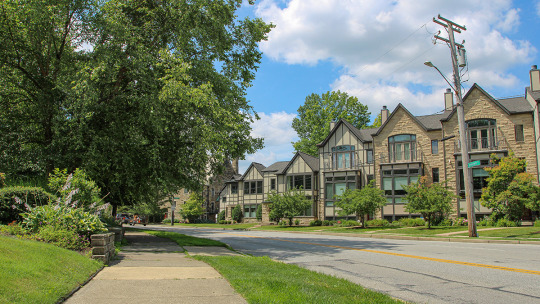
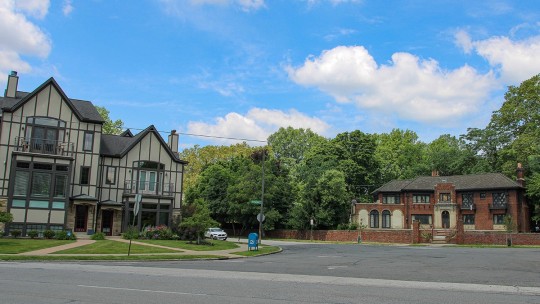
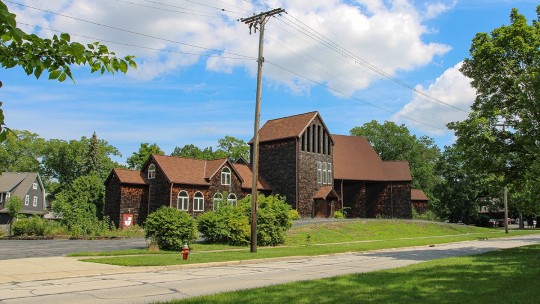

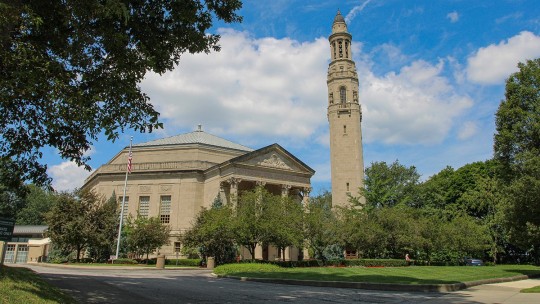
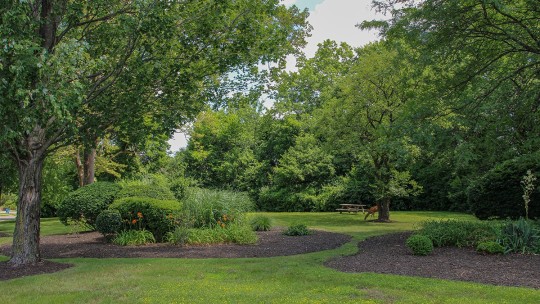
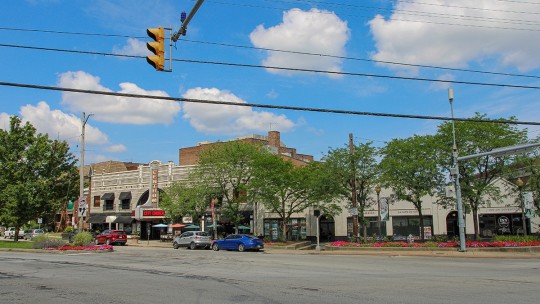
Euclid Heights Historic District
2729-2611 Edgehill Rd.
Cleveland Heights, OH 44106
Unlike other National Register Districts in Cleveland Heights, which are exclusively residential and exclusively single-family, the Euclid Heights Historic District's building types and architectural styles create a rich portrait of American upper and middle-class lifestyles during the late 19th and early 20th centuries. This 365-acre suburb bounded by Mayfield Rd., Coventry Rd., Cedar Rd., and Overlook Lane, was one of the first platted in the desirable higher ground located along an escarpment above Cleveland's University Circle and Euclid Avenue. Early on, Euclid Heights’ developers sought to attract wealthy Millionaires’ Row residents who, in the late 19th century, had begun migrating eastward away from the city's pollution and commercial bustle. The development benefited from the advent of electrified streetcars, which could conquer the steep grades leading up to the Heights. Tucked in the corner of a green space framed by Doan Brook and Lake View Cemetery, Euclid Heights offered a stylish retreat where those able to handle longer commutes could enjoy spacious lots, curving streets, handsome architecture, spectacular views, fresh air, privacy and a chance to put distance between themselves and the increasingly dirty, problem-plagued city below.
The story goes that Atlanta and New York railroad lawyer Patrick Calhoun, grandson of U.S. Vice President and Senator John C. Calhoun, traveled to Cleveland on business in 1890. Having time to spare, Calhoun rode out to Lake View Cemetery to see the recently dedicated memorial to the slain President James A. Garfield, a structure Calhoun’s family had supported. On the way he noticed the building boom going on in the East End (Hough area), and wondered where that was heading. Calhoun had been involved earlier in the Richmond Terminal railroad project in Virginia and was familiar with the groundbreaking work that Frank Sprague, the "Father of Electric Traction," had done there in using electric railroads to promote urban development. Knowing that the East Cleveland Railway Company had recently done some innovative work electrifying streetcars locally, Calhoun saw an opportunity to develop an important streetcar suburb at the top of Cedar Glen.
Working with local partners, including John D. Rockefeller's real estate man, J.G.W. Cowles, attorney William Lowe Rice and merchant John Hartness Brown, Calhoun had development plans drawn up by 1892. The Panic of 1893 put their plans on hold but by 1896 an amended site plan was recorded—more or less identical to today's layout of the area with Euclid Heights Boulevard bisecting the site from the southwest corner at the crest of Cedar Hill. In the northeast corner of the development would be the commercial district, what we now know as Coventry Village. Other prominent features included The Overlook—Overlook Road southwest of Edgehill Road and featuring large mansions featuring splendid north- and west-facing views—and the Euclid Club, a country club that sported a golf course spanning both sides of Cedar Road and a grand quarter-mile entry path beginning at what is now the corner of Derbyshire and Surrey Roads.
The development gradually attracted fine homes and also spurred other beautiful subdivisions, such as Barton Deming’s Euclid Golf Allotment on the south portion of the former golf course (which closed in 1912). Moreover, the Van Sweringen brothers, are believed to have been paperboys in the Euclid Heights area and later went on to adopt themes from the Euclid Heights Allotment in their famous Shaker Heights and Shaker Farm communities (the latter comprises streets such as Stratford, Marlboro, Fairfax and Guilford, west of Lee Road and immediately north of Fairmount Boulevard) . Calhoun, however, was distracted by legal problems running the San Francisco streetcar franchise after the Great Earthquake and saw his Euclid Heights development company forced into bankruptcy in 1914. By then William Rice had been murdered while walking home to the Overlook from the Euclid Club, a sensational case that featured John Hartness Brown as a suspect. Although it still maintains its picturesque “Garden City” look, Euclid Heights soon evolved from a private hilltop retreat to a busy gateway to the rapidly developing Heights. A large portion of Calhoun-owned land in the area’s eastern sector was sold off and subdivided, thus explaining why Cleveland Heights homes east of Coventry Road tend to be somewhat more modest than those near the top of the hill. Euclid Heights was listed with the National Register of Historic Places on October 31, 2012. It remains full of architecturally significant homes (including Calhoun's at 2460 Edgehill), but its main significance is the role it played in opening the Heights as a streetcar suburb for wealthy Clevelanders.
0 notes
Text
Derby Cathedral: A historic gem in the heart of Derby
Derby Cathedral, originally established in 943, stands proudly as one of the most captivating historic sites in Derby. With its rich heritage and significant monuments, it serves as a testament to Derby’s and Derbyshire’s past. Inside its walls, a wealth of treasures awaits visitors, including the tomb of Bess of Hardwick, a memorial dedicated to Florence Nightingale, and a stunning wrought iron screen crafted by the talented Robert Bakewell.
The Enlightenment
During the Enlightenment period, the nave of Derby Cathedral underwent a remarkable transformation. In 1725, architect James Gibbs redesigned it in a Neo-Classical style, imbuing the interior with simplicity and an abundance of natural light. Despite having only two modern stained-glass windows, the cathedral’s plain interior is beautifully balanced by the inclusion of a magnificent wrought-iron chancel screen, skillfully fashioned by the local iron-smith Robert Bakewell. Stretching across the width of the church, this screen stands as a prominent feature and a testament to the craftsmanship of the time.
Derby Cathedral
Activities
The Bridge Chapel: Beyond the walls of Derby Cathedral, visitors can explore the nearby Bridge Chapel, a short 5-minute walk from the cathedral itself. Situated along the banks of the River Derwent, this medieval bridge chapel is one of only six remaining in the entire United Kingdom. Built to provide spiritual solace to travellers, it also served as a toll collection point for those crossing the bridge into Derby.
Guided Tours: For those seeking a deeper understanding of the cathedral’s history and significance, guided tours are available to individuals, groups, organizations, and clubs. Led by experienced guides, these tours offer valuable insights into the cathedral’s past, its monuments, and the workings of the cathedral itself.
Tower Tour: One of the highlights of a visit to Derby Cathedral is the opportunity to embark on a tower tour. This unique experience allows visitors to climb one of the tallest church towers in England, standing at an impressive 212 feet and consisting of 189 steps. From the top, breathtaking panoramic views of the city and its surroundings can be enjoyed. Additionally, the tower is available for private tour hire, providing an exclusive and memorable experience.
Cathedral Treasures: For those with an interest in ecclesiastical silverware, the Cathedral Treasures await discovery. Housed in the Sir Richard Morris Room of the Cathedral Centre, this collection showcases remarkable pieces, some dating as far back as 1491, with several originating from the reign of Queen Elizabeth I. Regrettably, the Sir Richard Morris Room is currently not open to casual visits from the public.
Timing:
Monday, Tuesday, Thursday, Sunday: 09:00 – 17:15 Wednesday and Saturday: 09:00 – 17:00 Located just a brief 5-minute drive from The Stuart Hotel, Derby Cathedral offers a convenient and enriching experience for visitors. It is one of the best hotels in Derby near Derby train station – just a 5-minute walk away.The hotel is conveniently positioned on the bustling London Road (A6). After a day of exploration, retreat to our modern, comfortable, and spacious rooms for a restful night’s sleep. Alternatively, indulge in a delectable culinary experience at our fully equipped bar and restaurant, the ideal way to complete your stay. Learn more: www.aghotels.co.uk/the-stuart-hotel
0 notes
Text

CHATSWORTH HOUSE
Chatsworth House in Derbyshire is a historic English country estate that has served as the home of the Dukes of Devonshire and their ancestors since the mid-16th century. It is one of the finest country houses in the Peak District, drawing countless visitors into its opulent halls every year. The first house to be built on the Chatsworth House site was constructed in 1549 by Bess of Hardwick and her husband Sir William Cavendish. This original estate was notable for its use as a prison for Mary Queen of Scots, who was kept here on several occasions between 1569 and 1584. Little remains of the original structure except the Hunting Tower which still stands on the hill behind Chatsworth House. It was not until 1686 that the 1st Duke of Devonshire began a major re-building programme at the house, constructing most of what survives today. While the 2nd and 3rd Dukes largely left the architecture of the house alone, they amassed its huge collection of notable artwork, from Ancient Greek and Roman sculpture to Old Master drawings.
Today Chatsworth House is open to the public and is operated by the Chatsworth House Trust. The house boasts a wealth of interesting art, furniture and antiques as well as exceptional architecture throughout a number of its stunning rooms. A must-see at Chatsworth House is the amazing Devonshire Collection, which displays an array of interesting items from the family’s personal collections. The estate has a wonderful 105-acre garden which is also open to the public and includes a large maze, farmyard, and adventure playground. Wild-swimming often takes place in the river, while at Christmas Chatsworth is famously redecorated for immense festive celebrations.
History Hit. (n.d.). Where to Wild Swim and Bathe in History in the Peak District. [online] Available at: https://www.historyhit.com/locations/chatsworth-house [Accessed 25 Sep. 2023].
youtube
0 notes
Text

Gone to rack and ruin?
By Vice Admiral Sir Timothy Laurence | Published 29 July 2020
Country Life Guest Edited by HRH The Princess Royal
What on earth do you do with a ruined, but historically significant country house?
This is a question that plagues the average workaday heritage chairman, causing headaches, insomnia and occasional bouts of teeth-grinding. Here, I will use four examples from the English Heritage portfolio to illustrate the challenges we face. Country Life readers may have their own views about how we should deal with them; if so, I anticipate a flood of letters offering advice. Each site is different and no one solution fits all.
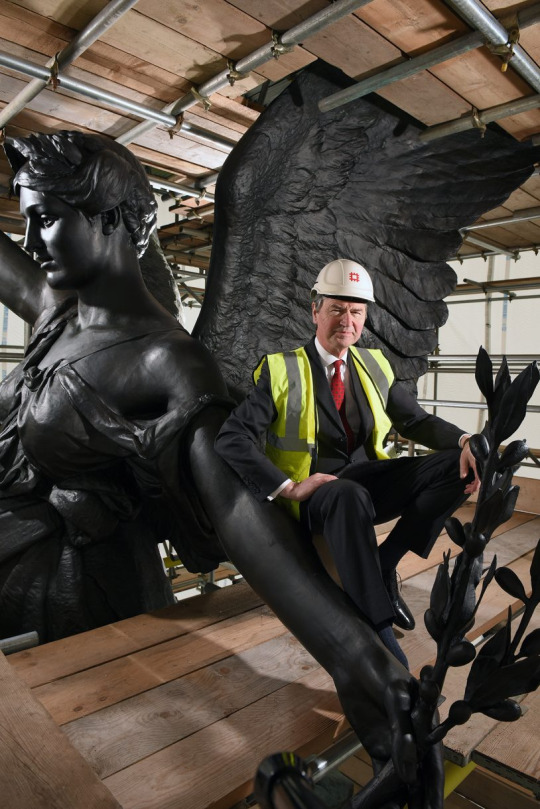
Kirby Hall
Kirby Hall in Northamptonshire was built in the 1570s by Sir Humphrey Stafford and, after his death, by Sir Christopher Hatton, Lord Chancellor. This magnificent house shows all the creative energy and architectural innovation of the first Elizabethan age.
In the 17th century, it hosted five royal visits and boasted one of the finest gardens in England. After four generations of Hattons (all called Christopher in that charming, if rather confusing, English way) it passed to the Winchilsea family, who lived there until the 1770s. Abandoned in the 1830s, it is now roofless, but retains enough of its form for us to imagine how astonishing it would have looked when first built.

John Summerson wrote: ‘The beauty of Kirby’s decline is that it was private and without violence. The house was never burnt, ravaged, used as a quarry or assaulted by mobs.’ English Heritage looks after buildings that suffered exactly those fates, but because Kirby was spared all of them, one can still appreciate there the romance of a lost grandeur.
What should we do with it? The Ministry of Works in the 1960s did its usual thorough, if, by current standards, a little over-zealous, conservation job. Part of the house is still roofed, but leaks are threatening the ceilings underneath. One proposal was to re-roof a further part of the house — the Great Gallery — and use it to display a collection of contemporary furniture, paintings and so on.
That idea has not yet passed the ‘value for money’ test. We are currently working on a modest new exhibition, which will be completed later this year. Major additional work would require a substantial funding package to match.
Sutton Scarsdale Hall

Sutton Scarsdale Hall in Derbyshire is another example of the rise and fall of a noble country house and is one of our greatest conservation challenges.
It was a Baroque masterpiece, built in the 1720s for the 4th Earl of Scarsdale using some of the notable craftsmen of the day. The splendid exterior stonework was carved by Edward Poynton of Nottingham; the Italian master craftsmen Arturi and Vasilli carried out the fine stucco decoration in the principal rooms, remnants of which are still visible.
The cost of the building over-stretched the Scarsdales — an all-too-familiar story, I��m afraid — and the house was sold in the 19th century to a local family, the Arkwrights. In turn, they were forced to sell in 1919 to a company of asset strippers.
Despite the fact that Lord Curzon’s 1913 Ancient Monuments Consolidation and Amendment Act had by then provided the Government with protective powers, many of the hall’s finely decorated rooms were sold off as architectural salvage.
Amazingly, some still survive, but sadly not in Derbyshire: three interiors are displayed at the Museum of Art in Philadelphia and a pine-panelled room is at the Huntington Library in California. The latter was given to the library by a Hollywood film producer, who had used it as a film set for Kitty in 1934. He had bought it from the newspaper magnate and collector, William Randolph Hearst.
More happily, the hall was saved from intended demolition in 1946 by Sir Osbert Sitwell. His descendants handed it to the nation in 1970.
The roofless hall stands proudly on a prominent hill, an important part of the visual landscape of the area and visible from Bolsover Castle across the valley. However, the exposed hilltop location and lack of protection from a roof or glazed windows make the building itself, and especially the exceptionally important plasterwork, acutely vulnerable.
We are currently spending considerable sums patching and making good, but, for a charity such as us, this cannot be a long-term solution. What should we do? One option would be to re-roof the whole hall — at huge expense. Another would be a partial re-roofing to cover the best areas of plasterwork.
A third would be to devise some form of tailor-made protection for the plaster-work in situ, but anything of this nature would have significant aesthetic impact. We have even thought of a private investor taking it over and turning it into a hotel or apartments. All options remain under consideration.
Witley Court
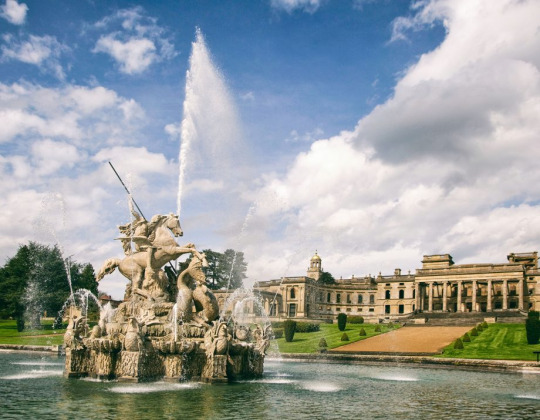
My third example presents a very different set of issues. A new house was built on old foundations at Witley Court in Worcestershire in the early 1500s, but eight generations of the Foley family (all called Thomas — rather proving my earlier point) progressively modernised the Tudor original in Jacobean, then Palladian style, enlarged the park, built a new parish church next door and, in the early 19th century, commissioned John Nash, the leading Regency architect, to remodel the house extensively.
In 1837, ownership passed to Lord Ward, later Earl of Dudley. During the Dudleys’ tenure, the house was transformed into a ‘Victorian palace’ in the Italianate style made fashionable by Prince Albert at Osborne.
The whole house and church were encased in Bath stone; a new wing and a conservatory were added. Among many additions to the gardens was the magnificent Perseus and Andromeda fountain, fed from a new reservoir in the hill behind.
As happened so often elsewhere, the estate began to be broken up after the First World War and, in 1937, a serious fire gutted much of the building. From then until it was taken into public guardianship in 1972, it was stripped of materials and vandalised, but, thereafter, it was stabilised and made accessible. The great fountain continues to operate for an hour each day and looks magnificent after a major restoration in 2004 and further work in 2016, the latter generously funded by Unilever.
Visitors can now enjoy the park and gardens and wander through the house, where the fire has revealed the various stages of its development.
There are no plans to re-roof the main house, but how can we enhance the pleasure of visiting the place and bring more of its history to life? For example, we are considering digitising the many excellent photographs of the interiors taken during its heyday, so that people can call them up on their mobile phones as they walk round.
We would like to refurbish the conservatory as a cafe. This would require expensive works to bring in services, yet those might enable us to produce more events there, following the very successful art exhibition held in 2019 — perhaps that was a harbinger of things to come.
Belsay Hall
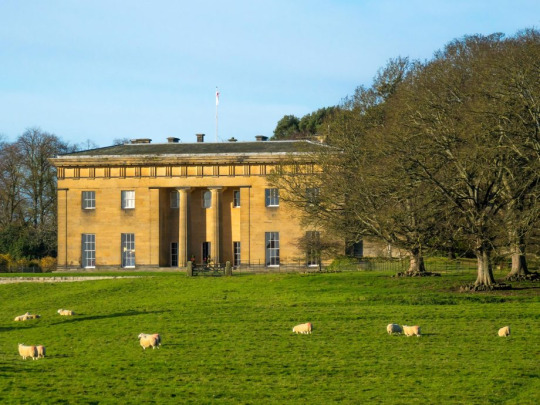
Now, at last, for something with a roof — Belsay Hall in Northumberland. The site comprises three distinct, but related elements: a medieval castle, a 19th-century hall and, linking the two buildings, an outstanding garden. The Middleton family has owned the estate since 1270 and still lives nearby.
The hall’s designer, Sir Charles Monck, drew on the classical ideal he had seen on honeymoon in Greece and transposed the style of a Greek temple into an English villa from 1807 (Fig 6). Its sense of space, balance and rigorous architectural logic were unlike anything seen in Britain. Incidentally, Monck demolished the old village of Belsay on the site and rebuilt it in its current position outside the park — the sort of thing you could do in those days.
He deliberately quarried the stone for the hall in a way that left space for a unique garden, the ravines, pinnacles and sheer rock faces he created inspired by the ancient quarries of Syracuse, Sicily. The gardens still showcase the interplay between natural beauty and the sublime, between wild and tame, from natural woodland through the exotic-ally planted quarry to the more formal terraces and garden rooms near the house.
The family moved from the draughty castle to the new hall on Christmas Day 1817. Sadly, flaws in Monck’s internal guttering system led to wholesale infestation with dry rot. By 1980, when the family handed the buildings and garden into public guardianship, it was unoccupied, unfurnished and stripped of much internal wood and plasterwork. The silver lining of this cloud is that it is now possible better to appreciate features of its design. Standing in the beautiful central atrium,
it does feel more like a temple than a house. The windows are huge, allowing in plenty of natural light, and the acoustics are exceptional, thanks to the empty rooms, vast cellars and a network of flues.
Sound, light and empty space may hold the key to its future use; it is an ideal place for creative programming. We have in the past held innovative fashion and art shows there and have staged acoustic experiences, one with voices broadcast down the chimneys. There will, I am sure, be more of this.
We are in the middle of a major project, part funded by the National Lottery, which includes urgent conservation work, a full restoration of the gardens and a new cafe. The Middleton family and its trustees remain engaged, supportive and, I hope, appreciative of the promise of a new lease of life for Belsay.
These four examples illustrate the enormous technical and financial challenges we face with these and other houses. It’s not unreasonable to ask: why are we doing this? What is the purpose behind a heritage body preserving and/or conserving a building?
Well, we want the places to be informative — to tell us something about the people who built them, about their architectural style, about the people who lived in them or who visited them. It’s all part of explaining the story of England to current and future generations, not only to please or inform expert historians and architects, but to encourage a much wider body of people to see and enjoy our buildings.
From school groups (we host many) to local enthusiasts and anyone who has become fascinated by these places — perhaps after reading about them or seeing a Google arts fly-through online. We hope they will all want to see more, to learn more and enjoy (that word again) the experience.
We have to ask: should we preserve such buildings as they are now, strip them back to their original state when first built or restore them to how they appeared at the height of their glory? With our intact houses — such as Osborne, Apsley or Audley End — the answer is as self-evident as it is with a completely ruined castle or abbey: there really is no option. However, my examples here and others fall between those stools. There are no straightforward answers; we have to look at each on its own merits.
Total returns to past glories are rarely feasible, but allowing further decline is not in our DNA. More commonly, we seek to stabilise each place in a state of ‘sustainable conservation’ — a condition that we can maintain in the long term, avoiding costly repeated repairs. It is an evidence-based way of prioritising work according to historical significance, current condition and a better understanding of the specific causes of deterioration. Once in that state, the typical approach is ‘adaptive re-use’: bringing a building back to life by giving it new uses, which complement, rather than obscure the original.
Above all, these houses must be nurtured and loved so that they can tell their part of the story of England. English Heritage will do what it can, helped by the communities living nearby, many of which provide terrific support — and, perhaps, by the occasional generous benefactor.
77 notes
·
View notes
Text
Must-Visit Historic Sites Around Hathersage
Explore the rich history of Hathersage, from medieval churches and castles to literary landmarks and industrial heritage. Discover Little John’s grave, North Lees Hall, and more. Plan your visit now and uncover the timeless charm of this Derbyshire village.
#historic sites Hathersage#Little John’s grave#North Lees Hall#Peveril Castle#Eyam plague village#Padley Gorge history#Chatsworth House#Hathersage industrial heritage#historic villages Peak District#literary landmarks Derbyshire#The George
0 notes
Text
Discover the wonders of Derbyshire with our guide to the top attractions near The Maynard. Featuring a curated list of 20 scenic and historic sites, this guide is your ticket to exploring the beautiful landscapes and rich heritage of the area. Perfect for tourists and locals alike, find everything from stately homes to natural parks, ensuring your adventures are both enriching and memorable.
#Derbyshire attractions#The Maynard#travel guide#places to visit near Maynard#Derbyshire tourism#Peak District#historic sites Derbyshire#outdoor activities Derbyshire
0 notes
Text
In light of all the horrid stuff going on in this country lately, I would just like to remind everyone that england isn’t a totally terrible place!!
This country is full of beautiful architecture, art, literature, and natural beauties that are sometimes hard to believe are real.

This is the Major Oak of Sherwood Forest, and is estimated to be as much as 1100 years old!! It is estimated at 23 tons, and is 33 feet in girth/10 metres. According to local folklore, it is the tree where Robin Hood and his merry men slept when in the forest.

This is Durdle Door, in Dorset. It’s a natural limestone formation on the jurrassic coast, which was deemed “of such international geographic importance” that it was England’s first foray natural World Heritage site with UNESCO in 2001, joining the Grand Canyon and the Great Barrier Reef (visit-dorset.com)
As for architecture, we have the iconic Highclere Castle

Most well known for its use in iconic historical drama Downton Abbey, first written records of the Highclere estate date back to the year 749 when the estate was granted to the bishops of Winchester. In the late 14th century the bishop of Winchester William of Wykeham built himself a palace on the property, and was taken by Edward VI during the reformation in 1551. It was then granted to the Fitzwilliam family, rebuilt in 1679 by then owner Sir Robert Sawyer, who then bequeathed it to his daughter Margaret, first wife to the 8th earl of Pembroke, Thomas herbert, and it remains in the hands of the Herbert family to date, albeit the branch that resulted in the current Earl of Carnarvon. It was redesigned in the years 1842-49 to the facade we know today. (Quick side note, I am directly related to the herbert family through my great grandfather, so carnarvon I’m coming for you watch out)
We also have of course, the ever iconic Chatsworth house

IYKYK. Jk this incredible house is most well known for its use as Pemberley, the Derbyshire residence of Mr Darcy in the 2005 production of Pride and Prejudice (the best film ever made thank you very much).
The Manor of Chetesuorde is listed in the Domesday Book of 1086 as property of the crown in the custody of William de Peverel. Chatsworth ceased to be a large estate until the 15th century when it was purchased by the Leche family. They enclosed the first park and built a house on what is now the south east part of the gardens. The lands were sold in 1549 to Sir William Cavendish, husband of Bess of Hardwick (who was the “keeper” of Mary Queen of Scots while imprisoned. Also apparently her grandson married ANOTHER of my ancestors so I’m related to her too?? What the fuck I need to stop learning family history on the fly). Bess began to build her own home on the property from 1553 to the 1560s.
The home was renovated a truly mindboggling amount of times, as is the amount of times it changed hands. So I’ll keep it simple. A great number of important changes were made by the 4th duke of Devonshire, greatly changing the layout of the home. His son would marry Georgiana Spencer, 4 times great aunt of princess Diana (and YET ANOTHER RELATIVE OF MINE! From another branch of the family!! I need to call my mother. And update my ancestry.com).
In 1811 the 6th duke of Devonshire inherited Chatsworth, and proceeded to transform it into the wonderful beacon of regency romance we know and adore today over the course of his stewardship over the property.
These are only four incredible natural and historical landmarks in England. There are so many more that I could spend 3 life times researching!! (And so many more that have nothing to do with my family history, I promise. Swear I wasn’t doing this on purpose lmao)
This country can be a fucking nightmare, but it’s also a beautiful country with incredible sights and history, and I think we do ourselves a disservice when we forget that. It’s okay to love England (I fucking adore this country you have no idea, wouldn’t be running a blog if I didn’t!), you aren’t a bad person or supporting the bad shit we’ve done if you are proud of being English.
Because don’t get me wrong this country has perpetrated some of the worst shit in history, but we’ve also contributed some of the most important literature and scientific discoveries ever!!
Mary Anning revolutionised the field of paleontology!! Mary Shelley started the entire sci fi genre. Steven hawkin, Charles Darwin, Dorothy Hodgkin and Rosalind franklin discovered DNA! Isaac Newton, William Blake, John Keats, Byron, Alan Turing, Branwell, Charlotte, Emily, and Anne bronte, Dante Gabriel Rossetti, John Everett Millais, John William Waterhouse, to name a few merely off the top of my head!
England can be a wonderful place, and our heritage can be incredible and a legacy to be truly proud of. It would not do to forget, however, that a lot of our history would not have been possible without queer and ethnic minority groups. We all know a good deal of English wealth came from the slave trade, female scientists and artists often had credit for their work stripped from them and given to husbands or even strangers, and a good number of our most influential scientists and artists were very notably queer who were treated incredibly poorly and sometimes killed, and these are facts that can and do exist simultaneously.
Our heritage is wonderful, but it is still being made today. Things that we do now will be landmark events for our descendants, and it is our duty to do better for this country than our ancestors.
#long ass post sorry#I’m In A Mood today#apologies for the absolutely bizarre turn into my family history I genuinely did not expect to be related to like everyone involved in this#i severely underestimated how intertwined the nobility is#I would love to chat with anyone about some fascinating bits of English history they know and am happy to elaborate on anything I possibly#can!#politics#english history#chatsworth house#highclere castle#dorset#sherwood forest#english culture#trans rights#durdle door#can’t tag everything or I’ll be here all day#Admin Roe
51 notes
·
View notes
Text
Rubble, and Rammed Earth in Architectural Design
During World War Two, rubble was created from the Blitz Bombings, where hundreds of buildings were flattened. Due to the density of Portsmouth, any bombs that dropped caused devastating amounts of damage.
A lot of the most historic buildings across the city were destroyed in the bombings, and the buildings that took their place never quite matched what was there before (The Portsmouth Blitz, 2022).
However, some of these bomb sites were turned into sites of hope. Sites which became playgrounds, markets, and garden parties. They reminded people of what had happened, but inspired people, leaving them hopeful about the future of the war (Staveley-Wadham, 2022). The bombings unleashed layers of soil that had previously been built over, and were turned into spaces where flowers could bloom and flourish.
People often began to innovate, and create new methods of cooking food from artefacts that you may find at a bomb site. At Stanton County School, in Burton, Derbyshire, the Swadlincote and Stanton Civil Defence cooked meals 'consisting of cottage pie, peas and carrots, followed by a sweet and a cup of tea' (Staveley-Wadham, 2022) using these materials, showing that even the rubble from a bomb site can be put to use for good.
However, the leftover bomb sites were also hazardous, as they became a dumping ground for rubbish and other waste, germ infested, as well as being an inviting place for rats as well. There had been a lot of deaths directly due to these bomb sites, where broken walls had given way. People protested about how they needed homes, not bomb sites, trying to get the government to do something and start the process of rebuilding. So while the bombsites had momentary positives, on the whole, they were scars on the landscape, which is why most of these sites were hastily rebuilt over (Staveley-Wadham, 2022).
Across the UK, a lot of the rubble left in cities was transported to other countries, used as weight for the ships. Some of the UK's rubble was used in expanding the land mass of Manhattan, New York. In Liverpool, a lot of the cities rubble was put on Crosby Beach, and you can still see bricks and rubble there to this day. Some of the rocks and stones along this beach hold deeper clues, as some are parts of old gravestones (Schultz, 2019).
It is likely that in Portsmouth, the rubble was moved off Portsea Island due to the lack of space. It may have been used to solidify the Southsea coastline, to prevent erosion and damage to the defence structures (Why – Southsea Coastal Scheme, n.d.).
Through researching into the rubble that was left over from the World War Two bombings, I started to think about how rammed earth could be used as a building tool.
Portsmouth as a city lacks the open green space where traditionally you may source more sustainable building materials from such as wood. However rammed earth in construction may be a solution to this, and could have been adopted after the war if the knowledge of this method was wider known.
Rammed earth architecture occurs in places where the soil is suitable to be used for this purpose. It is more suitable in warmer, drier places, as opposed to the UK. It is often used in Australia because of this reason. It involves ramming soil, stone, gravel and clay into formwork structures, which, when the earth is dry, are then removed to leave the constructed wall. It has been used for thousands of years due to the lack of skill needed to complete it. It has been used in Morocco a lot, where the red soil is formed into red-tinged structures on top of hills. Testing would need to be done on the rubble and leftover soil from the Blitz to determine whether it would have been suitable for construction in some form (A Guide to Rammed Earth Construction - First in Architecture, 2019).
It is interesting to think about whether I could incorporate rammed earth into my design, but I think with the quality of soil that is required, it is not feasible to do this in the UK.
A Guide to Rammed Earth Construction - First In Architecture. (2019, July 23). First in Architecture. https://www.firstinarchitecture.co.uk/rammed-earth-construction/#:~:text=Rammed%20earth%20construction%20is%20suited
Schultz, I. (2019, November 6). Liverpool’s Crosby Beach Is a Mile of World War II Blitz Rubble. Atlas Obscura. https://www.atlasobscura.com/articles/liverpool-beach-war-archaeology#:~:text=Tons%20of%20the%20rubble%20were
Staveley-Wadham, R. (2022, May 19). The British Newspaper Archive Blog Bomb Sites In The 1950s | The British Newspaper Archive Blog. Blog.britishnewspaperarchive.co.uk. https://blog.britishnewspaperarchive.co.uk/2022/05/19/living-with-bomb-sites-in-1950s-britain/
The Portsmouth Blitz. (2022). Welcometoportsmouth.co.uk. https://www.welcometoportsmouth.co.uk/the%20blitz.html
Why – Southsea Coastal Scheme. (n.d.). Southseacoastalscheme.org.uk. Retrieved April 14, 2023, from https://southseacoastalscheme.org.uk/project-overview/why/
3 notes
·
View notes
Photo

Lourdes Grobet, a contemporary photographer born in Mexico City, sought to challenge the disciplinary boundaries between painting and photography through her Painted Landscapes series. As an art student in England in 1977—at the height of the punk revolution—Grobet used her camera to document local landscapes that she had drastically altered with colorful house paint. Grobet’s professor failed her, and Derbyshire residents called the police.
In 1982 and 1983, still inspired, Grobet returned to this concept, siting her experiments across her Mexican homelands in Morelos, Michoacán, and Oaxaca. Grobet’s images challenge the historical premise that photography is a space of uninvolved documentation. The environmental sculptures seen in her work can point to the artistic intervention of landscapes that ultimately become industrialized.
Posted by Jenée-Daria Strand Lourdes Grobet (Mexican, born 1940). Untitled (Cactus Painted Blue), ca. 1986. Silver dye bleach photograph (Cibachrome). Brooklyn Museum, Gift of Marcuse Pfeifer, 1990.119.11. © artist or artist's estate
#womenshistorymonth#outofplacebkm#lourdes grobet#mexico#mexico city#5womenartists#women artists#landscape#paint#colorful#photography#painting#mexican#brooklyn museum#bkmphotography
105 notes
·
View notes
Text
England: ”This Earth of Majesty”

7/26/19 - ENGLAND. The mother to the modern world’s business tongue. A country within the United Kingdom within Great Britain and none of us can make any sense of what the heck the difference is. This wondrous place is an island I’d always dreamed of visiting from the first time I picked up The Chronicles of Narnia. Or Pride and Prejudice. Or Harry Potter. The list goes on. From its rich history, its captivating architecture, and the many famous humans that have walked these streets, England is not a country to be missed.
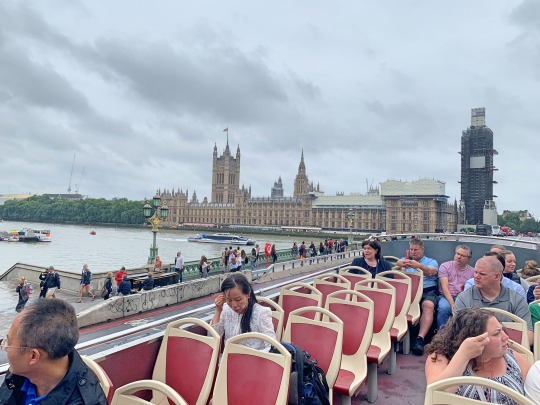
We arrived in London on a Friday evening. The summer in the U.K. is much like Seattle; the sun is fickle and the rain needy. Seeing the countless parks throughout the city, not to mention the luscious greenery throughout the countryside, it’s no wonder it rains so much here. On Saturday morning, we met up with a friend to do a proper tour of the city. For the day, we purchased a “London Pass” which gets you into over 75 attractions as well as access to the Hop on Hop Off bus. We swiftly made our way to the top of the double decker, not caring that the open-roof was a bit damp and paying notice to the “mind your head” signs up the stairs. As we embarked through the city, a man with a microphone prompted us to grab headphones and listen to his countless facts about London.

Did you know that there are actually two Londons? Greater London refers to the American definition of “London”. This is where the Queen hails and is generally what we think of when referring to London. There is also “The City of London”, a square mile within Greater London that can be easily identified by its dragon statues which guard its borders. The City of London is separately governed, collects separate taxes, enforces separate laws, has their own separate flag, and even elects their own Lord Mayor. Queen Elizabeth isn’t even allowed to enter the City of London without permission from the Lord Mayor. It’s all very scratch-head worthy.

There’s a laundry list of sites to see in London. There’s Big Ben (currently under construction), Westminster Abbey (filled with famous and infamous corpses), Buckingham Palace, the Tower of London, Tower Bridge (much cooler than London Bridge), the Churchill War Rooms, Shakespeare’s Globe, and loads more. One would need to devote an entire week to site seeing just to manage it all in. Needless to say, we didn’t get to see everything, but we managed to get some good ones under our belt.
Our first stop was at the Tower of London, just a hop, skip, and a jump away from Tower Bridge on the north bank of the River Thames (pronounced “Tems”). The Tower of London is less of a tower and more of a series of towers that feel more like medieval grounds from something out of a storybook. Within each tower holds its own treasures and stories. There was original armor, crown jewels, the bloody tower (where two princes were believed to have been killed by their uncle so that he could have the crown for himself), prison cells (where names and images have been carved into walls)...and so much more. You could spend all day at this site alone, but we hurried on off to lunch after building up an appetite..must have been all the murder stories that did it. Speaking of murder - walking across the Tower Bridge, we found the street where many Jack the Ripper scenes were filmed. They even offer evening tours of all his murder spots (a big no thank you from me).

The food in England is a journey in and of itself. If you ask for pie, don’t expect something sweet. A traditional English-style breakfast consists of toast (seemingly the most important food group), beans, mushrooms and/or tomatoes, an over-easy egg, a hash brown, bacon (which is actually more ham-like), and sausage (tastes more like fake meat to me). We can’t tell you how many times we ate the same English-style breakfast, but it really was quite hearty. Brunch will sometimes include all-you-can-drink. And let’s not forget Sunday roast! Tea was also a staple for most, if not all, of our breakfasts - I like mine with two sugars and milk. In terms of stereotype foods, we didn’t see a crumpet in sight.
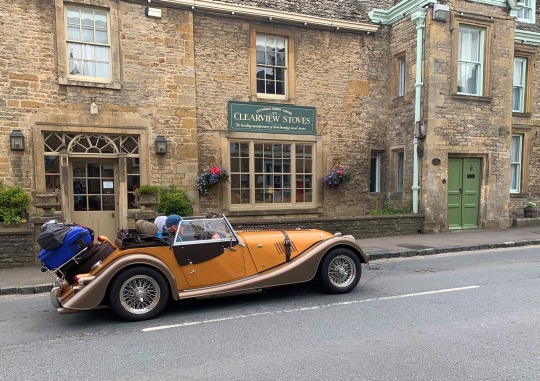
While London is a must-see when in England, it’s certainly not the highlight of the country. We rented a car and made our way north, with our final destination being Scotland. We’d arranged to have overnight stays in aribnb’s along the way, taking recommendations from our very own Rick Steves. The street signs were comical, seeing ones like “mind the gap” and “queues likely”. Getting used to the different terminology is a journey of its own. First stop was Stow-on-the-Wold; a quaint little market town with sandy-colored buildings, friendly town folk, and shops around every corner. We still aren’t sure what a Stow or a Wold is, but while we passed through, it was clear why it was a place outsiders wanted to visit. After spending a few days in the city, it was refreshing to be in a small town. We managed to only go down the wrong side of the street towards oncoming traffic once, so that’s a bonus!

Shortly following our pit-stop to Stow-on-the-Wold, we found our airbnb in a place known as Derbyshire, arriving promptly at 3:00 PM. A woman answered the door and greeted us by saying, “you’re positively punctual”. She sounded like Mary Poppins and I could’ve swore she was about to break out in song next and a bird would likely land delicately on her finger. That was when I really realized we weren’t in Kansas anymore. She took us upstairs to our room in her large, historical cottage. The backyard view reminded me of something out of a Jane Austen novel. I could imagine Mr. Darcy coming to our door by horseback. We had dinner at a local gastropub, just up the street. The server told us about a place to visit the following day, which we promptly agreed we’d do.

The next morning on our way out of town, we stopped by the recommendation from our server; a nature walk toward an abandoned water mill. During our walk, Rob stopped and asked that I take a picture of him in the grass. At the time, I had no idea why. Turns out he was envisioning a scenic view out of Gladiator and just HAD to reenact it. Making our way down a long drive, we saw a flock of pheasants that we thought were chickens. When we finally did make it to the water mill, we took in the beautiful views and imagined what sorts of things must have taken place throughout history here; a common thought through such a historical place. When we thought there wasn’t a living soul in site, a couple of women on horseback road passed. Such a slow, easy going lifestyle here.
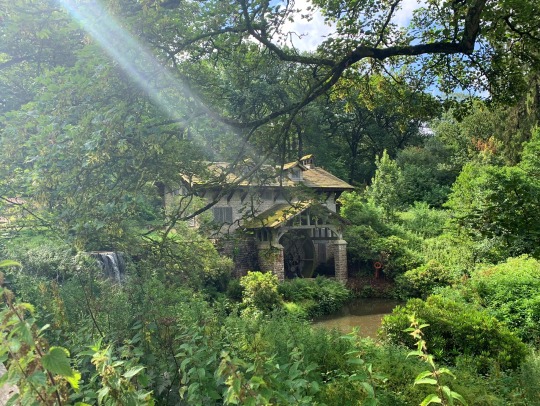
Our next destination was what is known as the lake district; more specifically, a town called Keswick (pronounced Ke-sick). Keswick was by far our favorite stopping point. It had a German feel with British flavor. Lots of nature, lots of shops, and lots of kind people. This is a popular spot to visit in the summertime for Brits throughout the country. While rain was to be expected, we lucked out for the day we spent there and enjoyed a pleasant nature hike.



The day following our trip to Keswick, the weather took a turn for the worse. We were so fortunate to have such a beautiful day for our one day spent there. After our time in the lake district, our next stop was Scotland. Truly, Scotland is deserving of its own blog, so stay tuned for that next! Instead, I’m going to fast forward to when we trained back to London.

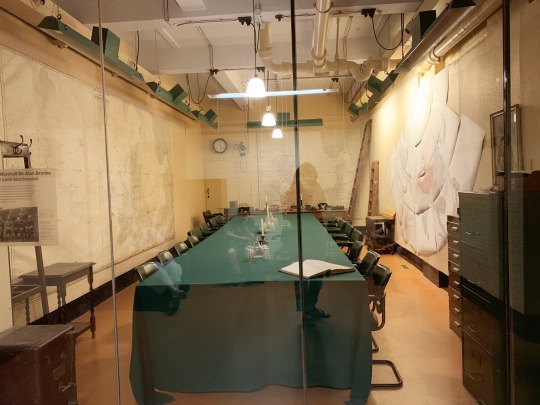
We’ve gone full circle and made it back to the city. Our train arrived at Kings Cross Station - so naturally we visited platform 9 3/4. After taking our obligatory Harry Potter photo, we decided to try to squeeze in any last minute sightseeing we may have missed. That’s how we ended up at the Churchill War Rooms. The underground tour is the original housing spot for Churchill and his men during WWII. They have kept the rooms in mostly the same condition with a full audio tour to really envision what it must have been like during the war. Trying to imagine being trapped down there while bombs continued to go off upstairs was a very humbling experience. For me, having been to the war museums in both Pearl Harbor and Okinawa, seeing the war through the British lens was a new perspective. On one of the original maps in the discussion room, you could even see a drawing of Hitler someone had done. A really remarkable site and I would highly recommend to anyone who visits London. Speaking of sights in London, did you know that all museums are free in the UK? That led us to the Natural History Museum! Among other things.

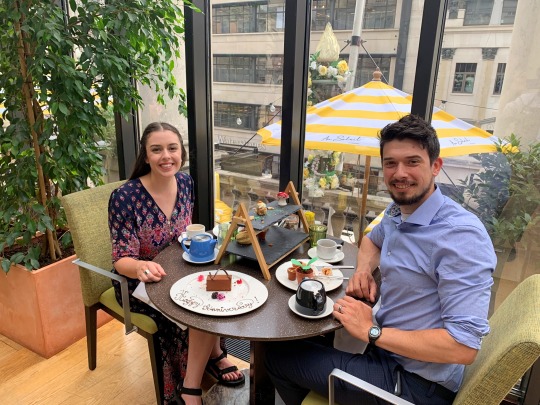
On 8/3/19, our 5-year wedding anniversary, we decided to treat ourselves to high tea. We had reservations at a delightful little spot in the city. The theme was Peter Rabbit and ohhhh was it good! We had mini-sandwiches, biscuits, jams, and treats to the max. Everything you see was edible, including the flower pots. I don’t think I stopped smiling once. When we had finished, we were stuffed beyond belief. Then the server comes over with a HAPPY ANNIVERSARY dessert. We couldn’t NOT eat it...so we stuffed our little bunny bellies. Another successful wedding anniversary outside of the states - once an accident, now a tradition. <3
If you’re considering a trip to the UK, I’d say go Nike and just do it! Some of our expectations were met and others were shattered, but that’s the joy of travelling. A place is never how you think it’s going to be, but seeking the different is what is exciting. Stay tuned for the next blog where we’ll share our adventures in Scotland - my new crush. Thanks for sticking it out and reading along!
3 notes
·
View notes